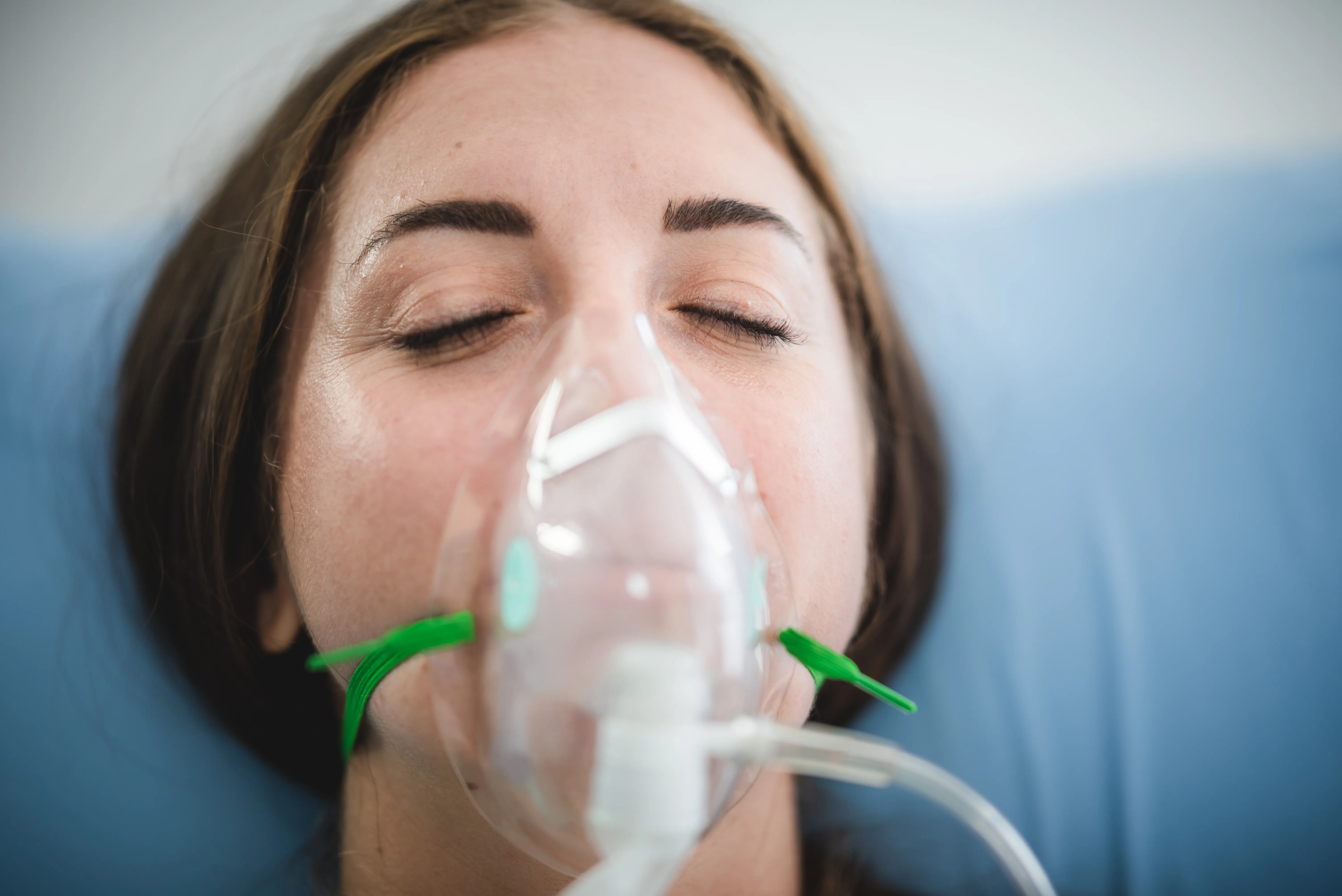Oxygen plays a vital role in keeping our physical health better and our bodies functioning properly, and its levels naturally fluctuate during the process of sleeping. While a slight drop in oxygen saturation is normal due to relaxed breathing, significant decreases can indicate underlying health conditions.
In this article, we will break down what constitutes a normal oxygen level during sleep and what factors can lower it; this is crucial for maintaining overall well-being.
What Is a Normal Oxygen Level During Sleep?

A normal oxygen level during sleep typically ranges between 90% and 100% SpO₂ (oxygen saturation). However, slight dips in oxygen levels are common due to changes in breathing patterns during sleep.
Understanding Oxygen Saturation (SpO₂)
Oxygen saturation (SpO₂) refers to the percentage of oxygen carried by red blood cells from the lungs to the rest of the body. It is typically measured using a pulse oximeter, a small device that clips onto a fingertip and detects oxygen levels through light absorption.
Maintaining proper oxygen levels is essential, as insufficient oxygen (hypoxemia) can lead to fatigue, cognitive impairment, and severe health complications over time.
Normal Oxygen Levels While Sleeping
For a healthy individual, normal oxygen saturation levels are:
- Awake: 95% to 100%
- During Sleep: 90% to 95%
A mild drop in oxygen levels is normal during sleep, as breathing slows down. However, significant drops below 90% may indicate an underlying issue such as sleep apnea, chronic obstructive pulmonary disease (COPD), or other respiratory conditions.
How Oxygen Levels Change Throughout the Sleep Cycle
Oxygen saturation is not constant throughout the night—it changes based on different sleep stages:
- Light Sleep (Stages 1 & 2): Oxygen levels remain relatively stable, though slightly lower than wakeful levels.
- Deep Sleep (Stage 3): Breathing becomes more regular, and oxygen saturation stays steady.
- REM Sleep (Rapid Eye Movement): Oxygen levels fluctuate the most due to irregular breathing patterns and temporary pauses in breathing, especially in people with conditions like sleep apnea.
A consistent decline in oxygen levels, particularly during REM sleep, can indicate an underlying respiratory or neurological issue that disrupts normal breathing.
What Causes Low Oxygen Levels During Sleep?
Several factors can contribute to decreased oxygen saturation at night, some of which are temporary, while others may indicate a chronic health issue.
Sleep Position
Your sleep posture can influence how efficiently your lungs take in oxygen. Sleeping on your back can cause the tongue and soft tissues in the throat to collapse, partially obstructing the airway and reducing airflow.
This is especially common in individuals with sleep apnea or obesity. Sleeping on your side can improve oxygen levels by promoting better airflow.
Learn more about the Best Sleeping Position For Breathing Problems.
Age and Lung Function
As we age, lung capacity gradually declines, making it more difficult for the body to maintain high oxygen levels. This natural decrease can contribute to mild oxygen desaturation during sleep, especially in older adults with existing lung conditions.
Sleep Apnea and Breathing Disorders
Obstructive sleep apnea (OSA) is one of the most common causes of low oxygen levels at night. It occurs when the airway becomes partially or fully blocked, leading to pauses in breathing and repeated drops in oxygen saturation.
Central sleep apnea, a less common type, is caused by the brain failing to send proper signals to the breathing muscles.
Altitude and Environmental Factors
Living at high altitudes can result in lower oxygen levels due to the reduced air pressure, which makes it harder for the lungs to absorb oxygen efficiently. Poor air quality, allergens, and smoking can also reduce oxygen intake by causing airway irritation and inflammation.
Cardiovascular Conditions
Heart-related issues such as congestive heart failure (CHF), coronary artery disease, and arrhythmias can impair blood circulation and reduce oxygen delivery to tissues. These conditions can lead to lower oxygen levels during sleep, causing symptoms like shortness of breath and night sweats.
Neurological Disorders Affecting Breathing
Certain neurological conditions, such as ALS (amyotrophic lateral sclerosis), Parkinson’s disease, and multiple sclerosis (MS), can weaken the respiratory muscles, making it difficult to maintain normal oxygen levels. Neurological damage can also interfere with the brain's ability to regulate breathing properly.
Obesity and Lifestyle Choices
Excess weight, or obesity, particularly around the abdomen and chest, can restrict lung expansion and limit airflow, leading to obesity hypoventilation syndrome (OHS) and lower oxygen levels.
Smoking, alcohol consumption, and a sedentary lifestyle can also negatively impact lung function and oxygen absorption.
Symptoms of Low Oxygen Levels During Sleep

When oxygen levels drop significantly during sleep, it can lead to noticeable symptoms that affect sleep quality and overall well-being. These symptoms may be mild at first but can worsen over time if the underlying cause is not addressed.
Frequent Awakenings or Restless Sleep
Low oxygen levels can cause frequent sleep disturbances, leading to multiple awakenings throughout the night. The body instinctively wakes up to restore normal oxygen levels, preventing deep, restful sleep.
Morning Headaches
A lack of oxygen during sleep can lead to the buildup of carbon dioxide in the bloodstream, resulting in headaches upon waking. These headaches typically subside after breathing normalizes.
Excessive Daytime Sleepiness
Poor oxygenation at night can lead to excessive daytime sleepiness and insufficient rest, leaving individuals feeling exhausted, groggy, and unable to concentrate during the day.
Shortness of Breath
Some individuals may wake up gasping for air due to a sudden drop in oxygen levels. This is commonly seen in people with sleep apnea or respiratory conditions.
Episodes of Gasping or Choking During Sleep
Interrupted breathing patterns, often caused by obstructed airways or weak respiratory muscles, can result in gasping, choking, or sudden jolts out of sleep.
Increased Heart Rate or Irregular Heartbeat
When oxygen levels fall, the heart must work harder to circulate oxygen-rich blood, leading to an increased heart rate or irregular heartbeat (arrhythmia). Over time, such changes can strain the cardiovascular system.
Health Risks of Low Oxygen Levels During Sleep
Chronic low oxygen saturation can have severe health consequences, affecting multiple organs and increasing the risk of serious medical conditions.
Cardiovascular Issues
Prolonged low oxygen levels can lead to high blood pressure, heart arrhythmias, and an increased risk of stroke or heart disease. The heart compensates for the lack of oxygen by pumping harder, which can cause long-term damage.
Cognitive Impairment
Oxygen deprivation can affect memory, concentration, and cognitive function, leading to brain fog and an increased risk of neurodegenerative diseases like Alzheimer’s.
Weakened Immune System
Chronic hypoxia (low oxygen levels) can suppress the immune system, making individuals more prone to infections, inflammation, and slower healing processes.
Metabolic Issues
Low oxygen saturation has been linked to insulin resistance, weight gain, and metabolic disorders like type 2 diabetes. Poor sleep quality due to oxygen deprivation can disrupt hormonal balance, leading to increased hunger and poor glucose metabolism.
How to Improve Oxygen Levels During Sleep

Ensuring optimal oxygen levels during sleep is essential for overall health and well-being. By making targeted lifestyle changes and seeking medical intervention when necessary, individuals can improve their sleep quality and reduce the risks associated with low oxygen levels.
Maintain a Healthy Sleep Position
Sleeping on your back can sometimes cause airway obstruction, especially for individuals with sleep apnea. Instead, sleeping on your side or with your upper body slightly elevated can help keep airways open and improve breathing. Using a wedge pillow or an adjustable bed can provide additional support.
Use a CPAP or BiPAP Machine (If Diagnosed with Sleep Apnea)
For individuals with obstructive sleep apnea, a Continuous Positive Airway Pressure (CPAP) or Bi-level Positive Airway Pressure (BiPAP) machine can help keep airways open by delivering a steady stream of air pressure. These devices significantly improve oxygen levels and prevent nighttime breathing interruptions.
Improve Air Quality
Ensuring good air quality in the bedroom can help maintain healthy oxygen levels. Using a humidifier to prevent dry air, keeping rooms well-ventilated, and using air purifiers to remove dust, allergens, and pollutants can contribute to better breathing at night.
Stay Active and Maintain a Healthy Weight
Regular exercise improves lung function, increases oxygen efficiency, and helps maintain a healthy weight. Excess weight, particularly around the neck and abdomen, can restrict airflow and contribute to low oxygen levels during sleep.
Engaging in activities like walking, swimming, or yoga can strengthen respiratory muscles and improve breathing.
Monitor Oxygen Levels Regularly
For individuals experiencing symptoms of low oxygen levels during sleep, using a pulse oximeter can help track oxygen saturation. This simple device clips onto a finger and provides real-time readings of blood oxygen levels, helping detect potential issues early. Consulting a doctor for further evaluation may be necessary if oxygen levels consistently drop below 90%.
FAQs
What Are Normal Oxygen Levels During Sleep?
Normal oxygen saturation (SpO₂) levels while awake range between 95% and 100%, while during sleep, they may slightly drop to 90% to 95%. A minor decrease is normal due to slower breathing. However, levels below 90% may indicate conditions like sleep apnea or lung disease and require medical evaluation.
Why Do Oxygen Levels Drop During Sleep?
During sleep, breathing naturally slows, and lung function decreases slightly, leading to mild oxygen level drops. However, factors like sleep apnea, poor sleep position, obesity, or lung disease can cause significant drops, leading to symptoms such as gasping, snoring, or morning headaches. Severe drops require medical attention.
How Can I Check My Oxygen Levels While Sleeping?
A pulse oximeter is a non-invasive device that clips onto a finger and measures oxygen saturation overnight. For more detailed monitoring, a sleep study (polysomnography) can assess oxygen levels, breathing patterns, and possible sleep disorders. If oxygen levels drop frequently below 90%, medical intervention may be necessary.
What Are the Symptoms of Low Oxygen Levels During Sleep?
Common symptoms include frequent awakenings, gasping for air, morning headaches, excessive daytime sleepiness, and irregular heartbeat. If left untreated, chronic low oxygen levels can contribute to cardiovascular disease, cognitive decline, and weakened immunity.
How Can I Improve My Oxygen Levels While Sleeping?
To improve oxygen levels, maintain a healthy sleep position, use a humidifier or air purifier, avoid alcohol and sedatives before bed, and stay active to strengthen lung function. If diagnosed with sleep apnea, a CPAP or BiPAP machine can help regulate breathing and maintain proper oxygen saturation.
Conclusion
Oxygen levels naturally fluctuate during sleep, but significant drops can indicate underlying health concerns that need attention. Conditions such as sleep apnea, lung disease, or poor lifestyle habits can contribute to low oxygen saturation, leading to fatigue, cognitive impairment, and long-term health risks.
By maintaining a healthy sleep position, improving air quality, staying active, and monitoring oxygen levels, individuals can enhance their breathing efficiency and sleep quality.
Dom Abraham
As the lead content writer at Sleepiverse. Dom pours his heart into writing mattress reviews, bedding product reviews, and medically-reviewed health articles. Dom is from Portugal and likes to spend his free time writing on the beach as it gives him a sense of comfort. Aside from writing mattress reviews in front of the soothing beach view, Dom likes to experiment with new amazing food ideas.


